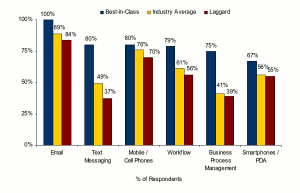
What is unified communications (UC) and why do you need it? UC is not unified messaging, and it isn’t a unified desktop. But both of these technology solutions help to support a unified communications architecture. In fact, according to Aberdeen, a Harte-Hanks Company, UC is the convergence of such technologies as instant messaging, e-mail, voice over Internet protocol (VoIP), presence and e-commerce in or near real-time.
UC solutions are provided by a variety of different vendors. Aberdeen breaks the vendor solution landscape into four categories: software providers, voice systems or data networking providers, SaaS (Software as a Service) providers, and network operator providers. Each of these solutions provides value to the right client. Now that companies have already begun to implement unified communications beyond just “headquarters,” Aberdeen explored the impact of UC in the contact center.
Enhancing Customer Interaction
In June and July 2008, Aberdeen surveyed 189 organizations to determine the impact of UC in the contact center and it discovered that nearly one quarter (23 percent) of respondents have implemented UC in the contact center. Moreover, the Aberdeen survey revealed that an additional 50 percent of respondents say that they are currently evaluating unified communications solutions for their contact center. The current adoption levels and continued adoption demonstrate the importance of unified communications.
But the question is, why are companies so interested? There are several reasons for this. According to nearly one half (45 percent) of organizations that took the survey, enhancing the customer interaction is a top reason for implementing UC in the contact center. Thirty-five percent say that increasing contact center revenue is a top driver for implementing UC in the contact center.
However, the implementation of a unified communications architecture within a company’s contact center isn’t without challenges. According to 46 percent of those surveyed, improper and misaligned policies are an obstacle to implementing a unified communications architecture in a contact center. One of the ways to avoid this problem is through the utilization of internal business process governance. Almost three-quarters (73 percent) of the Best-in-Class have governance for internal business processes. Beyond the interaction between a contact center agent and an expert resource, agents need to interact with each other as well as with management. Having the right cohesive rules in place to manage these relationships is critical to the success of agents and contact center management, which directly impact such key performance indicators as agent turnover.
Furthermore, who determines the internal business process governance is also important. Sixty-three percent of the Best-in-Class currently have a governance board and an additional 19 percent plan to create one. The establishment of a governance board specifically for contact centers reinforces the critical role that contact centers play in the customer interaction. It is this governance board that must play an important part in the successful role out of unified communications. UC is the technology that brings together traditionally disparate technologies in real-time and the governance board must make sure that the right people have the right access at the right time to the right information and expert resources. It has the best business perspective on how the unified communications architecture should be designed for the contact center due to its understanding of past governance decisions as well as future ones. Governance in the contact center is not something that is set in stone and it should be formulated keeping corporate policy in mind. It also adjusts as the business environment changes.
A Missed Opportunity
While there are hurdles to implementation, Aberdeen survey respondents indicate that there are several benefits to having implemented UC in the contact center; two of which are improved responsiveness to customer inquiries (36 percent) and improved team collaboration (32 percent). Both of these benefits substantiate the fact that UC enhances the customer interaction, an aforementioned factor driving companies to implement UC in the contact center.
Best-in-Class organizations have implemented several technologies in support of a unified communications architecture. The figure below shows the current technology adoption levels. One of the marked differences in adoption exists in text messaging. With similar adoption levels of mobile phones and smartphones, clearly non-Best-in-Class organizations are not taking advantage of an opportunity to add another touch point with expert resources and customers through the use of text messaging.
It is important for companies to understand how they compare to Best-in-Class organizations in order to determine what actions they must take to become a Best-in-Class organization. For example, Laggard firms must implement governance for internal processes and measure key performance indicators. Industry Average firms must create a governance board to monitor policies, procedures and authority within the contact center. Even Best-in-Class organizations have room for improvement. For those who do not already have a business process management solution in place, they must implement one. Only thirty-one percent of respondents indicate that they currently have presence in place. However, 34 percent of the Best-in-Class do say that they plan to implement it within the next 24 months. Best-in-Class companies must have this technology in order to maintain their competitive advantage.
On July 31, Aberdeen published a report on unified communications titled “Unified Communications: Lifeblood of the Contact Center.” This report can be viewed for free by clicking here.
Steve Lawrence is research associate in the customer management group at the Aberdeen Group.















































Social CRM
See all Social CRM